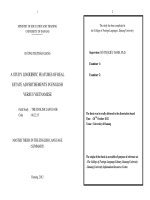(Real estate math handbook) geoffrey thompson, rich linkemer pennsylvania real estate math handbook
Bạn đang xem bản rút gọn của tài liệu. Xem và tải ngay bản đầy đủ của tài liệu tại đây (750.07 KB, 155 trang )
0/ 154
FEARLESS MATH
A Guide For Real Estate Agents
By
Geoffrey Thompson and Rich Linkemer
APPALLASO PRESS
Published by Appallaso Publishing
Revised 11-28-2016
1
www.pdfgrip.com
Contents
Introduction
Our Approach ................................................................................................. 3
Helping Guide: Terminology .................................................................................................. 4
Section I
...................................................... 6
Section II
Calculating Commissions .............................................................................. 44
Section III
Taxes ............................................................................................................. 59
Section IV
Financing ....................................................................................................... 76
Section V
Interest Due at Closing.................................................................................. 91
Section VI
Prepayment Penalty .................................................................................... 108
Section VII
.................................................................................................. 119
Section VIII
........................................................................................ 128
Section IX
Loan Origination ......................................................................................... 137
Section X
Rent ............................................................................................................. 144
Section XI
Water........................................................................................................... 149
About the Authors ............................................................................................................. 154
2
www.pdfgrip.com
Introduction
Our Approach
Research shows that the majority of all math problems that real estate professionals may face in their career
boils down to three areas:
1. The math necessary to pass the licensing exam;
2. The math necessary to understand a closing statement;
3. The math used when handling commissions, payments etc. in practice.
In order to master all three of these different areas, it is important that you first understand the most recurring
situations, and how to approach the calculations individually, before you tackle an entire closing statement.
Accordingly, we will begin by introducing to you the most common math situations in real estate, which will
both introduce the methodology of handling answers, as well as give you some easy problems to tackle that
where something goes (as a credit to the buyer or
seller, or as a debit to the buyer or seller) you will have the answer.
en have you move to the more
typical situations where there may be multiple calculations necessary to answer a question. These situational
exercises that come in the latter section most approximate the way most testing providers today present the
Closing Statement on the licensing exam.
We recommend that you try to work the problem out on your own before you advance to the explanation on
the succeeding page.
e closing
statements and similar real world cases.
3
www.pdfgrip.com
Helping Guide: Terminology
Prorations
With the exception of principal payments on a mortgage, many real estate expenses such as rent are paid in
advance. However, other expenses such as real property taxes and interest on a mortgage are paid in arrears.
Upon closing, these various expenses are prorated between the buyer and the seller to ensure that each is
responsible for the operating expenses of the property during his or her ownership. The most common items
to be prorated are sewer charges, interest on loans, rent, mortgage impounds, utilities, and real property
taxes.
There are two methods which can be used for proration calculations
the
year and
year.
The method used varies from state to state and industry to industry.
• A
(12 months × 30 days = 360 days).
• For
year calculations, remember: 30 days has September, April, June and November. All the rest
have 31 days, except February which has 28 days. (Do not worry about leap years.)
As we are including both methods in this math guide, if your course uses the
steps in blue. If your course uses a
year, follow the steps in red.
method, follow the
Part-Whole Rate
To make real estate math easier to do and quicker to complete, the following formula has been devised. It will
work on all types of real estate math, except area/volume problems, which require a different set of formulas.
The "T" structure says that all math problems require three items to complete the task (or six in the case of
taxation). The basic formula uses the parts of the "T" as Part, Whole and Rate:
• Part is always a "part" or piece of something, such as a commission is always part of the sales price.
• Whole is always the complete unit such as sale price, market value, or loan balance.
• Rate is always a percentage.
In the "T" formation, the part is always put into the calculator first. After this is entered, you must punch the
divide button, and then enter the whole or rate, whichever is listed in the problem. The resulting number will
be either whole or rate, which was not listed in the problem and is that for which you are searching.
The "T" lines are the horizontal divide line. If you have part and whole, part is divided by whole. The vertical
line is the multiply line. If you have rate, multiply it by sale price.
4
www.pdfgrip.com
Helping Guide - Settlement-Statement Worksheet
Settlement Date
Closing Date:
Sales Price
Buyer's Statement
Seller's Statement:
Debit
Debit
Credit
x
x
Seller's Loan
x
Seller's Interest
x
Seller's Prepayment
x
Commission
x
Other Seller's Charges**
x
Earnest Money
x
Buyer's Loan-New
x
Buyer's Interest-new loan
x
Buyer's Points (Discount points)-Loan Origination
x
Insurance (if new)
x
Appraisal & Credit Charge
x
Other Buyer's Charges
x
Taxes-not paid
Credit
x
x
Chattels-personal property Refrigerator, washer, dryer
x
x
Assumed Insurance
x
x
SUBTOTAL
x
x
DUE to SELLER
x
x
DUE from BUYER
TOTALS
x
x
x
x
x
x
If taxes have been paid, then credit seller, and debit buyer.
Listings expire on the day of closing. Legal descriptions include lot, block, subdivision, county, city, and state.
5
www.pdfgrip.com
Section I
Fearl
Question #1 Handling Purchase Price
If the purchase price on a property was $194,000, how would the purchase price appear on a
full settlement statement?
Remember: The seller is selling and the buyer is buying. Whenever you debit one
person and the other person is involved, you must debit and credit each of
them the same amount.
a.
b.
c.
d.
Debit the seller $194,000; credit the buyer.
Credit the seller $194,000; debit the buyer.
Debit the seller $196,000; credit the buyer.
Credit the seller $196,000; debit the buyer.
6
www.pdfgrip.com
Question #1 Handling Purchase Price - Solution
again at the question from the previous page:
If the purchase price on a property was $194,000, how would the purchase price appear
on a full settlement statement?
Remember: The seller is selling and the buyer is buying. Whenever you debit one
person and the other person is involved, you must debit and credit each of
them the same amount.
a.
b.
c.
d.
Debit the seller $194,000; credit the buyer.
Credit the seller $194,000; debit the buyer.
Debit the seller $196,000; credit the buyer.
Credit the seller $196,000; debit the buyer.
Correct Answer: B The seller sold the house so the seller gets a credit, and the buyer bought the house so
the buyer is charged. Always be sure to use the purchase price, never the asking (or listed) price.
7
www.pdfgrip.com
Question #2
Handling Loan Balance
How would a seller's loan balance to be paid off at closing be recorded on a closing (se ttlement)
statement?
Remember: The buyer is not involved in the seller's paying off an old loan.
a.
b.
c.
d.
As a credit to the buyer
As a debit to the seller
As a credit to the buyer and seller
It is not recorded at all.
Remember to try to figure this out before you click to proceed to the following page.
8
www.pdfgrip.com
Question #2
Handling Loan Balance - Solution
How would a seller's loan balance to be paid off at closing be recorded on a closing (settlement)
statement?
Remember: The buyer is not involved in the seller's paying off an old loan.
a.
b.
c.
d.
As a credit to the buyer
As a debit to the seller
As a credit to the buyer and seller
It is not recorded at all.
Correct Answer: B
The seller must be charged for what is still owed on the loan balance.
However, if the buyer assumed the loan to be paid off, in the question above, by the seller, than that amount
would be a credit to the buyer and a debit to the seller on the closing (settlement) statement.
9
www.pdfgrip.com
Question #3
Handling Interest
How would the interest due from the seller for the time used in the curren t month of settlement appear
on a settlement statement?
Assume for the test that all mortgages are paid on the first of the month in arrears! That means if a payment is
made on January 1, the payment was for the month of December (principal and interest). So if a mortgage is
paid off in the middle of the month, the loan balance remains the same, but the seller owes interest back to
the first of the month.
a.
b.
c.
d.
Debit the seller.
Credit the seller.
Debit the seller and credit the buyer.
The seller does not have to pay interest for the month of settlement.
figured this out correctly.
10
www.pdfgrip.com
Question #3
Handling Interest - Solution
How would the interest due from the seller for the time used in the current month of settlement appear
on a settlement statement?
Assume for the test that all mortgages are paid on the first of the month in arrears! That means if a payment is
made on January1, the payment was for the month of December (principal and interest). So if a mortgage is
paid off in the middle of the month, the loan balance remains the same, but the seller owes interest back to
the first of the month.
a.
b.
c.
d.
Debit the seller.
Credit the seller.
Debit the seller and credit the buyer.
The seller does not have to pay interest for the month of settlement.
Correct Answer: A If the seller owes interest, it is a debit (charge) to the seller. So of the closing takes place
on the 15th of the month the seller would owe interest back to the first of the month for 15 days. If the buyer
were assuming the loan, then the buyer would receive a credit for 15 days, owe interest for the rest of the
month and pay the mortgage payment on the first of the following month just like the seller would have done
if the property were not sold.
Time to move on to the following page for the next question.
11
www.pdfgrip.com
Question #4
Handling Prepayment Penalty
If the seller's bank charges a prepayment penalty*, how would it appear on a settlement statement?
*Prepayment penalty - The amount set by the creditor as a penalty to the
debtor for paying off the debt before it matures; an early withdrawal charge.
a.
b.
c.
d.
Credit the buyer.
Credit the seller.
Debit the buyer.
Debit the seller.
12
www.pdfgrip.com
Question #4
Handling Prepayment Penalty - Solution
If the seller's bank charges a prepayment penalty*, how would it appear on a settlement statement?
*Prepayment penalty - The amount set by the creditor as a penalty to the
debtor for paying off the debt before it matures; an early withdrawal charge.
a.
b.
c.
d.
Credit the buyer.
Credit the seller.
Debit the buyer.
Debit the seller.
correctly.
Correct Answer: D The seller sold the property and the Deed of Trust says that if the property is sold
before the total term of the loan, the lender has a right to charge an extra charge. (Prepayment penalty)
stion on the following page.
13
www.pdfgrip.com
Question #5
Handling Commission
If the seller agrees to pay the listing broker a commission, how would it appear on a settlement
statement?
Remember: Debit whoever agrees to pay the commission.
a.
b.
c.
d.
Debit the seller and credit the buyer.
Credit the seller and debit the buyer.
Debit the seller.
Credit the seller.
Think about the answer to this question before going to the next page to find out the correct answer.
14
www.pdfgrip.com
Question #5
Handling Commission - Solution
If the seller agrees to pay the listing broker a commission, how would it appear on a settlement
statement?
Remember: Debit whoever agrees to pay the commission.
a.
b.
c.
d.
Debit the seller and credit the buyer.
Credit the seller and debit the buyer.
Debit the seller.
Credit the seller.
Correct Answer: C Debit the seller always the full amount, even if a question indicates a split between a
selling and listing broker. In the unlikely event that you are told that the buyer has agreed to pay the
commission, then debit the buyer. In other words, debit whoever has agreed to pay the commission.
N
15
www.pdfgrip.com
Question #6
Handling Fees
How would a deed preparation fee, title search fee and/or a home inspection fee be recorded on
the closing statement?
Remember: Debit (if you take the "i" out of the word "debit" you have a debt)
whoever agreed to pay the bill!
a.
b.
c.
d.
As a debit to whoever agreed to pay the charges.
As a credit to the buyer.
As a debit to the buyer and a credit to the seller.
As a debit to the seller and a credit to the buyer.
See if you can figure this out yourself before clicking to move ahead to the following page.
16
www.pdfgrip.com
Question #6
Handling Fees - Solution
How would a deed preparation fee, title search fee and/or a home inspection fee be recorded on
the closing statement?
Remember: Debit (if you take the "i" out of the word "debit" you have a debt)
whoever agreed to pay the bill!
a.
b.
c.
d.
As a debit to whoever agreed to pay the charges.
As a credit to the buyer.
As a debit to the buyer and a credit to the seller.
As a debit to the seller and a credit to the buyer.
Correct Answer: A
Debit (charge) whoever agrees to pay the deed preparation fee.
17
www.pdfgrip.com
Question #7
Handling Earnest Money
A buyer deposited $1,500 with the listing broker as earnest money. How is earnest money recorded on
a closing statement?
Any money that someone else is bringing to the closing for the buyer is always a credit to the buyer. So
earnest money would always be
to the buyer.
a.
b.
c.
d.
Credit $1,500 to both buyer and seller.
Credit $1,500 to the buyer; debit the seller $1,500.
Credit the buyer only $1,500.
Debit the seller only $1,500.
Can you figure out the correct answer to this?
18
www.pdfgrip.com
Question #7
Handling Earnest Money - Solution
A buyer deposited $1,500 with the listing broker as earnest money. How is earnest money recorded on
a closing statement?
Any money that someone else is bringing to the closing for the buyer is always a credit to the buyer. So
earnest money would always be
to the buyer.
a.
b.
c.
d.
Credit $1,500 to both buyer and seller.
Credit $1,500 to the buyer; debit the seller $1,500.
Credit the buyer only $1,500.
Debit the seller only $1,500.
Correct Answer: C Credit the buyer because the broker, Title Company, or whoever is holding the money
will bring the money to the closing table.
19
www.pdfgrip.com
Question #8
Handling New Loans
How would a buyer's new loan be recorded on the closing (settlement) statement?
Remember: Someone else is bringing the loan to the closing!
a.
b.
c.
d.
As a credit to the buyer
As a debit to the seller
As a credit to the buyer and seller
It is not recorded at all.
to the next page to find out the correct answer.
20
www.pdfgrip.com
Question #8
Handling New Loans - Solution
How would a buyer's new loan be recorded on the closing (settlement) statement?
Remember: Someone else is bringing the loan to the closing!
a.
b.
c.
d.
As a credit to the buyer
As a debit to the seller
As a credit to the buyer and seller
It is not recorded at all.
Correct Answer: A
Because the lender will bring this money to the closing for the buyer.
21
www.pdfgrip.com
Question #9
Handling Interest
If a closing occurred on June 15, and the buyer obtained a new loan, interest would be owed up to the
end of the month of settlement. How would this entry appear on a settlement statement?
Remember: The buyer must pay interest up to the end of the month of settlement, so he actually pays interest
in advance so that principal and interest can begin the first of the following month. Then when the buyers
make their first payment they are paying in arrears for only one full month.
So what are you going to do here?
a. Debit the seller.
b. Credit the buyer.
c. Debit the buyer.
d. Credit the seller.
22
www.pdfgrip.com
Question #9
Handling Interest - Solution
If a closing occurred on June 15, and the buyer obtained a new loan, interest wou ld be owed up to the
end of the month of settlement. How would this entry appear on a settlement statement?
Remember: The buyer must pay interest up to the end of the month of settlement, so he actually pays interest
in advance so that principal and interest can begin the first of the following month. Then when the buyers
make their first payment they are paying in arrears for only one full month.
So what are you going to do here?
a. Debit the seller.
b. Credit the buyer.
c. Debit the buyer.
d. Credit the seller.
Correct Answer: C Debit the buyer from the day of closing up to the end of the month. So the buyer would
owe for 16 days. (Count on your fingers from the 15th to the 30th.)
23
www.pdfgrip.com
Question #10
Handling Loan Origination Fees
If a buyer obtains a new loan and the lender charges a loan origination fee (points), how would it
appear on a settlement statement?
a.
b.
c.
d.
Debit the seller.
Credit the seller.
Credit the buyer.
Debit the buyer.
24
www.pdfgrip.com









